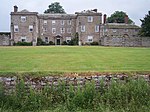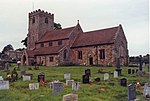Aldenham Park, Morville
Country houses in ShropshireGrade II* listed buildings in Shropshire

Aldenham Park, also known as Aldenham Hall, is a late 17th-century country house in Morville, near Bridgnorth, Shropshire, England which stands in 12 hectares of parkland. It is a Grade II* listed building.The house is built of ashlar in two-storeys with an 11 bay frontage and a raised parapet. It is approached via a lime-lined avenue through a set of ornate gates surmounted by the Acton family crest. The surrounding parkland is Grade II listed.
Excerpt from the Wikipedia article Aldenham Park, Morville (License: CC BY-SA 3.0, Authors, Images).Aldenham Park, Morville
A458,
Geographical coordinates (GPS) Address Nearby Places Show on map
Geographical coordinates (GPS)
| Latitude | Longitude |
|---|---|
| N 52.555131 ° | E -2.487037 ° |
Address
A458
WV16 4RR
England, United Kingdom
Open on Google Maps










